Social network classified
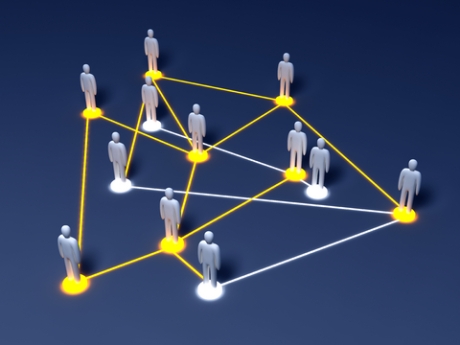
Social networks can be classified into 7 categories based on their purposes:
- Love and dating networks
- Friendship networks
- Business networks
- Job and Talent networks
- Communities (based on branding and companies, groups and fan clubs) and Knowledge networks
- Games networks
- Virtual worlds
The first kind of networks are Love and dating networks were amongst the first kind of online networks such as “meetic” or “Date.com” . It allowed users to find their matching in love. It was directly followed by more adult sites such as “Adult finder”. Love sites were immediately accepted by the public due a lack of social behaviour of urban youth. Millions of people around the world registered to those dating sites in order to find their love mate. According to Gartner, this sites are came into a mature fase in 2004.Today must of the people tend to seek their future love mate through Facebook or myspace were you have a broad view of the personality of the person you try to contact, sort of “tell me how are your friends and I tell you who you are”
Dating sites does not give a clear view of the person behind the profile thus the person can enter a false identity or even lie about his characteristics.
The second kind of networks who followed closely and logically the dating sites are “friendship networks” . The first to emerge were Classmates in 1995 and Friendster. Both are still found on the web besides being surpassed by younger social networks such as Myspace, Netlog or Facebook. Mainly due to the lack of a Multilanguage platform, but also from funny applications and friendly graphical structure. Myspace is considered to be a revolution in social networks and are considered to be the MTV of the web because musical talent can be discovered. Indeed Myspace is for the web what MTV was in the eighties in the music industry, Deejays, Musicians, singers and others gather together to share talent and promote talent. Must of this friendships sites started with students and developed into a more mature fase, first because those same students became part of the work system but also they spread the word and the trend (Facebook phenomenon). One thing in particular became clear for employees in their companies, youth organized quicker a party in a view clicks on Facebook than employees on outlook for their work meetings ! It became clear that the next level of network would be for professional purpose, therefore we come into the Third kind of network; “Business networks”.
It is clear that people inside companies had the necessity to keep track of their former employees not only for friendship but for sharing knowledge and to know what they had become. Sites like Linkedin, Xing, Plaxo, Viadeo and Naymz are sites were you can upload your curriculum on your profile. You become traceable to anyone who is interested your profile, whether it is for a career opportunity, a reference, a business deal or an introduction to a service or a product, once you are on a business site you are their because you want to be seen. Business sites can be defined into two kinds of networks, close networks and open networks. Close networks, users can only subscribe by invitation, asmallworld.com is a good example, this website was created for and by elite people in Europe, someone inside has the opportunity to invite a definite number of persons. Its users trade luxury goods and gather for special events.
Open networks concede a free registration to all users. Once registered users have several tools to search, contact and collaborate into different levels of the network. Even here free users have limitations, in order to monetize these networks, premium account have been created in order to permit its members to contact anyone inside the network without limitation. Linkedin provides its premium users only 5 INmails per month, that if not used can be added to the next month.
Viadeo and Xing have a different approach they allow their premium members to use fully their tools without limitation.
Since these networks have profiles of millions of professionals whom are passively open for career opportunity, several Recruitment firms used these tools in order to scout talents globally. Which resulted in the necessity to add job boards and company profiles to promote employer branding. This eclipsed jobsites such as Stepstone, Monster and Careerbuilder, who are changing their business models into a more friendly and social model.
The other kind of business network is “Ecademy” (which was found by Thomas Power) based in the UK. This is a “must be” for business. You can find investors or locate partners, create join ventures and find clients for your product and services. For a small fee users can benefit from their premium “Blackstar” account and be promoted on the network.
Job and Talent networks are similar to business networks, but are specialize into career opportunities. In this category you can find the renewed classical job and talent sites such as Careerbuilder or Monster and Stepstone but also freshly and more friendly sites such as Zumeo or Kasaiku. The registration of these sites are free, the only fee asked is for job posting by companies. Since these sites are specialized into career opportunities, they provide companies tools and application in order to facilitate their search for talent. On the other hand they have sophisticated tools for jobseekers in their search for jobs.
Communities is a category where I regrouped all the websites where people can innovate, share, collaborate to its content or develop its structure. These communities regroup people with the same interest or the with the same goals. It can be divided into two kinds, close communities, which can be companies or closed groups communities such as enterprise 2.0 where a group of people work together virtually for a common goal or even groups of scientist working for a purpose such as sharing knowledge or innovation “Innocentive”. The other kind are open communities where companies meet their client communities in order to promote its brand experience “Coca Cola, Procter & Gamble”. In open communities you can find all the other networks of common collaboration and sharing such as Flickr, Youtube , Wikipedia , Slideshare, Amazon and EBay. These communities are fundamental for crowdsourcing purposes.
Games network are simply communities inside online games who contribute to its development and knowledge (blogs, wikis) These are closed networks where only the game fan finds himself and speaks in name of his or her character in the game, it can be classified into virtual worlds I prefer not, due to its specific role on gaming. What I intend by virtual worlds are online 3D worlds without a specific attached scenario, where the user is free to follow its own story. Such as Second life or Moondus these networks can be defined as the 7 type of networks
Crossing or Xing?
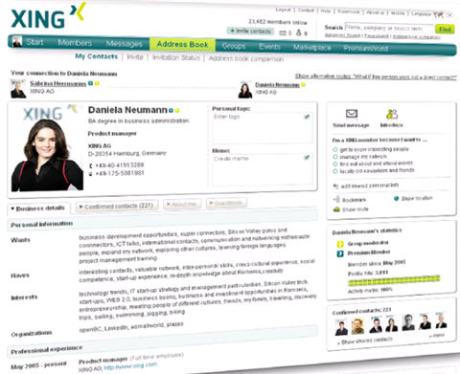
Xing profile
Xing is a German based business network that began in 2004. The network is structured for business and job purpose. The registration is free but practically all features can be used if a premium member is activated. All thou it is a business platform you don’t receive a receipt of payment.
Xing has 7 million registrations, Around 4 million are active users, others are considered sleepy due to its very passive activity. Xing has bought Neurona a Spanish business network in 2008. Hereby it has broken its German frontiers to enter a European playground of social networks. Numbers shows that 30% of its users are German ( or German speakers) another 15 to 20 % are Spanish users, the rest of the users are mostly European with the UK and Italy in front. To compare it with Linkedin, Linkedin has arrived to (March 2009) to 35 million users on which 60 % of the users in the American continent and growing number in India.
The other competitors of Xing is French based Viadeo.
On the free version you can customize your profile and add your known contacts to your profile. You can search for a job and you can be contacted by premium members.
If you register for the first time, you will have 6 months free premium memberships which provides you by far more features. The premium membership allows you to view and contact (indefinitely) any profile in the network. On Linkedin Premium it allows you to view profiles inside the whole network but the contacts are numbered by 5 a month. The premium membership provides its members to search and contact any profile, create and organize groups inside Xing, search and candidate to jobs or add jobs for a small fee.
The strength of Xing is its Multilanguage platform (16 languages including Chinese).
I have used Xing for talentscouting purposes and found it a very interesting application, also because you could use this application directly with your mobile, both downloading contacts as uploading. Linkedin premium costs 3 times more per month than Xing and it does allow you to sent only 5 mails per month, you can cumulate but what are 5 mails if you need to contact hundreds of people a month !? Xing allows you to contact indefinitely. Linkedin wins only by the numbers of registration. Xing has also another disadvantage, it has a lack on workspace application, which Linkedin has provided with a series of application, such as Box.net, Huddle, WordPress, Slideshare, etc.
This gives the profile the opportunity to use this platform as a workspace and stimulates crowdsourcing.
The future plans of Xing are new local marketing campaigns in order to promote this interesting business tool.
Real Life or Second Life

Second life
Several science fiction authors have predicted a world where humans will live as simulations. An illusion of a real world. All thou it was like living in another dimension, people were conscious of the fact that the world in question was not theirs. Since the first games emerged from the software industry, avatars were used as they obeyed to the player’s command. During all those years the graphic improuved as well as the interaction of the player. Virtual worlds were created to perfection.
Today there are two kinds of virtual worlds:
Massively Multiplayer online role-playing games
Massively Multiplayer online real life games
The internet evolutions has permitted players to join their games from all over the world simultaniously. The first kind of virtual worlds are games, where the player has a definite role an has to obey the game rules. The second type of virtual world has no rules whatsover and there is no goal attached to the game, it provides the condition to players as on the real life. VW such as Second life gives the users the opportunity to be part of its economy, avatars can work and do business, contribute to its environment by creating tools,clothes, buildings, buy real estate. There is even an exchange between real life money and second life money. Companies were quick to show interest in this new economy due to the fact that they were low to accept innovative economic structures such as Web 2.0 technology. Companies have their own advertisement, stores such as Apple or Nike have they own stores own second life where users can view the latest products. Selection agencies have already used this 3D platform in order to organize recruitment fairs or even selection.
Several scholars critize this new form of economic structure. They argue that Virtual worlds does not have many inhabitants, also people coming on second life, very few of them contribute to its economy. Also due to its high graphics only the latest computers can provide a user an adequate 3D sensation.
But on my opinion second life is just a pioneering site were the first real life simulation will be created. the whole internet will be a 3D simulation and companies must contribute to its development will be part of a future elite.
Besides Second life you have other Virtual worlds such as :
For others see page with list of online virtual worlds
In the future more virtual worlds will be created, portals are going to provide users jumps between one world to another. Sales online will grow on this 3D worlds, people will buy practically anything through this 3D worlds and exchange rates will provide an new kind of economic structure. Imagine a Facebook with 170 million inhabitants on a virtual world?
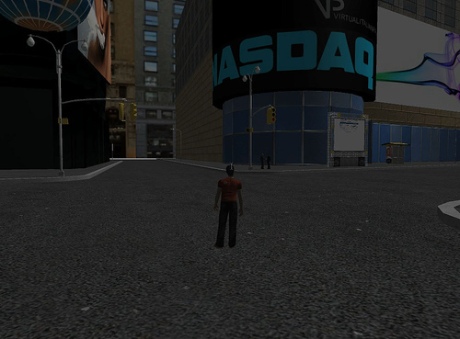
Moondus
Enter the Super Network
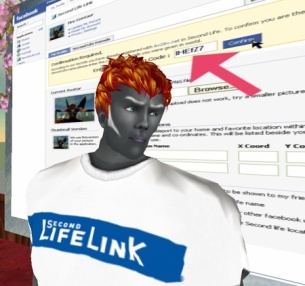
Facebook on Second life link your real friends and your virtual friends
Even the best Science fiction novels could not predict the future of humanity, interconnected as they are today.
The future of Social networking provides us plenty of surprises; what about talking to your friends online, while you are viewing your banking movements ! Imagine your are calling someone on Netlog via Skype and chatting with someone on Linkedin and Facebook simultaneously while you are working on Twitter and Xing or on Viadeo sharing files on Huddle or Weplus ! All that on the same network, a super network using 3D graphics such as second life, pc or mobile with portals through different networks interconnected for one purpose; to serve you !
This is not far from the truth, nowadays the online gaming industry has provided some interconnection between games, in order to switch between games bringing over your friends. Social networks are now entering into a mature faze, where they are monetizing their applications.
Only the biggest players will emerge from the crowd. This means that over hundreds of social networks, only a few will remain online to provide the user of all its necessity. Already today you can see some kind of a collaboration between social networks that allow users to add API’s from any network. In the future all networks are going to be merged into one network with all kinds of applications, from your office working station to a playground. The user will connect to the network and do everything it does both in the real life as virtual.
Second life is doing some steps towards collaboration with social networking sites such as Twitter, where you can connect in order to keep in touch with your projects. More and more applications will be added into the virtual world of second life. You will be on second life to visit shops online, buy clothes on virtual ebay, playing games, network with your friends online , through a portal that gets you to Facebook 3D on your mobile, seek business opportunities through Linkedin 3D or find a job on Secondlife Careerbuilders Portal. Another next level of web 3.0 application will be that people will share documents on 3D level through online platforms, working on their virtual office.
The world is changing tremendously, the economy is transforming towards a global networking collaboration, modifying to a complete new angle of the old hierarchical model of the Twentieth Century !
The changing in the economy is radical, more and more open source software’s are gaining notoriety. The way we think about an economic model of profits based on demand is changing drastically.
In order to understand the economic changes we must overview what was the economic model till now:
You invent a product, you sell the product with a profit margin in order to compensate the costs of production, use some marketing and sales and sell the product. Build a company with a capital that is based on bank loans, stock shares and sales revenues.
A simple product has a value on the market. The problem is that millions of people entered the global market with little purchase power. Now Both companies and consumers want to pay a low price to acquire a product ! In order to do that, you need to lower the costs of production. Previously companies closed their plants in their developed countries to move and rebuild them in the developing countries, but this was just postponing the problem. After the internet bubble in 2001 services and software’s were suddenly available for low prices or even for free on the market due to open source development. Companies such as Microsoft suffered from this change. It became known as the Web 2.0 economy “share, develop, collaborate, free”.
Companies need to accept the fact that they can lower the price of products such as low cost flights.
On the other hand consumers want to have quality from their products, the only way you can do that is to monetize the new web 2.0 economy.
The next step will be the collaboration between all networks, providing both quality of products and services for a low price.
Now after that the next step will be something similar to the matrix simulated world where people plug themselves into it, working and living into a virtual real world where it will be difficult to tell the difference between the real and the simulation ! I hope this time we will be conscious of the fact that it is still a virtual world !
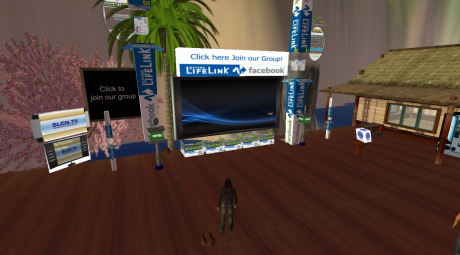
Snapshot from facebook link on secondlife
-
Archives
- May 2009 (1)
- April 2009 (4)
- March 2009 (4)
- February 2009 (5)
- January 2009 (4)
-
Categories
-
RSS
Entries RSS
Comments RSS

